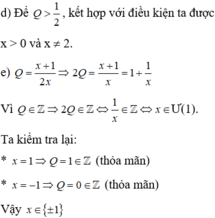Cho biểu thức A=(x^2+4x+5)×(4x-12)/2x-6
a. Tìm điều kiện của x để biểu thức A có nghĩa
b. Rút gọn biểu thức A. 😉😉
Hãy nhập câu hỏi của bạn vào đây, nếu là tài khoản VIP, bạn sẽ được ưu tiên trả lời.

a) ĐKXĐ:
\(\left\{{}\begin{matrix}\sqrt{x}-2>0\\\sqrt{x}+2>0\\\sqrt{4x}>0\end{matrix}\right.\\ \rightarrow\left\{{}\begin{matrix}\sqrt{x}>2\\\sqrt{x}>-2\\2\sqrt{x}>0\end{matrix}\right.\\\rightarrow \left\{{}\begin{matrix}x>\sqrt{2}\\x>-\sqrt{2}\\x>0\end{matrix}\right.\\ \rightarrow x>\sqrt{2}\)
Vậy \(x>\sqrt{2}\)
b)
\(M=\left(\dfrac{\sqrt{x}}{\sqrt{x}-2}+\dfrac{\sqrt{x}}{\sqrt{x}+2}\right).\dfrac{x-4}{\sqrt{4x}}\\ =\left[\dfrac{\sqrt{x}.\left(\sqrt{x}+2\right)+\sqrt{x}.\left(\sqrt{x}-2\right)}{\left(\sqrt{x}-2\right)\left(\sqrt{x}+2\right)}\right].\dfrac{\left(\sqrt{x}-2\right)\left(\sqrt{x}+2\right)}{2\sqrt{x}}\\ =\dfrac{x+2\sqrt{x}+x-2\sqrt{x}}{\left(\sqrt{x}-2\right)\left(\sqrt{x}+2\right)}.\dfrac{\left(\sqrt{x}-2\right)\left(\sqrt{x}+2\right)}{2\sqrt{x}}\\ =\dfrac{2x}{\left(\sqrt{x}-2\right)\left(\sqrt{x}+2\right)}.\dfrac{\left(\sqrt{x}-2\right)\left(\sqrt{x}+2\right)}{2\sqrt{x}}\\ =\dfrac{2x}{2\sqrt{x}}=\dfrac{x}{\sqrt{x}}=\dfrac{\sqrt{x}.\sqrt{x}}{\sqrt{x}}=\sqrt{x}\)
Vậy \(M=\sqrt{x}\)
a) ĐKXĐ:
\(\left\{{}\begin{matrix}\sqrt{x}-2>0\\\sqrt{x}+2>0\\\sqrt{4x}>0\end{matrix}\right.\\ \rightarrow\left\{{}\begin{matrix}\sqrt{x}>2\\\sqrt{x}>-2\\2\sqrt{x}>0\end{matrix}\right.\\ \rightarrow\left\{{}\begin{matrix}x>4\\x>-4\\x>0\end{matrix}\right.\\ \rightarrow x>4\)
Vậy \(x>4\)

\(a,ĐK:x\ne\pm2\\ b,A=\dfrac{5x+10+14x-28-20}{2\left(x-2\right)\left(x+2\right)}=\dfrac{19\left(x-2\right)}{2\left(x-2\right)\left(x+2\right)}=\dfrac{19}{2\left(x+2\right)}\\ c,x=-\dfrac{1}{2}\Leftrightarrow A=\dfrac{19}{2\left(2-\dfrac{1}{2}\right)}=\dfrac{19}{2\cdot\dfrac{3}{2}}=\dfrac{19}{3}\)

Câu 2:
a: Ta có: \(P=3x-\sqrt{x^2-10x+25}\)
\(=3x-\left|x-5\right|\)
\(=\left[{}\begin{matrix}3x-x+5=2x+5\left(x\ge5\right)\\3x+x-5=4x-5\left(x< 5\right)\end{matrix}\right.\)
b: Vì x=2<5 nên \(P=4\cdot2-5=8-5=3\)

a) ĐKXĐ: 3x + 6 khác 0
x khác -2
b) A = (x² + 4x + 4)/(3x + 6)
= (x + 2)²/[3(x + 2)]
= (x + 2)/3
c) Khi x = 1/4, ta có:
A = (1/4 + 2)/3
= (9/4)/3
= 3/4

a) x ≠ 0 , x ≠ − 2
b) Ta có D = x 2 - 2x - 2.
c) Chú ý D = - x 2 - 2x - 2 = - ( x + 1 ) 2 - 1 ≤ -1. Từ đó tìm được giá trị lớn nhất của D = -1 khi x = -1.

a) x ≠ 2 và x ≠ 0
b) Rút gọn được Q = x + 1 2 x
c) Thay x = 2017 (TMĐK) vào Q ta được Q = 1009 2017


a: ĐKXĐ:\(x\notin\left\{2;0\right\}\)
b: \(C=\left(\dfrac{x\left(2-x\right)}{2\left(x^2+4\right)}-\dfrac{2x^2}{\left(x-2\right)\left(x^2+4\right)}\right)\cdot\left(\dfrac{2-x^2+x}{x^2}\right)\)
\(=\dfrac{-x^3+4x^2-4x-4x^2}{2\left(x-2\right)\left(x^2+4\right)}\cdot\dfrac{-\left(x-2\right)\left(x+1\right)}{x^2}\)
\(=\dfrac{x\left(x^2+4\right)}{2\left(x-2\right)\left(x^2+4\right)}\cdot\dfrac{\left(x-2\right)\left(x+1\right)}{x^2}=\dfrac{x+1}{2x}\)
c: Thay x=2017 vào C, ta được:
\(C=\dfrac{2017+1}{2\cdot2017}=\dfrac{1009}{2017}\)

a: ĐKXĐ: \(x\notin\left\{2;-2\right\}\)
\(A=\dfrac{-\left(x+2\right)}{x-2}-\dfrac{4x^2}{\left(x-2\right)\left(x+2\right)}+\dfrac{x-2}{x+2}\)
\(=\dfrac{-x^2-4x-4-4x^2+x^2-4x+4}{\left(x-2\right)\left(x+2\right)}\)
\(=\dfrac{-4x^2-8x}{\left(x-2\right)\left(x+2\right)}=\dfrac{-4x}{x-2}\)